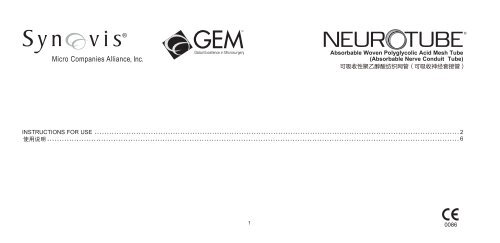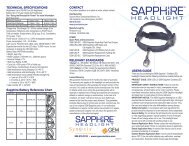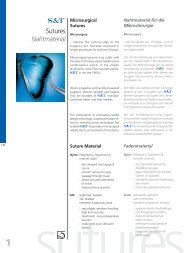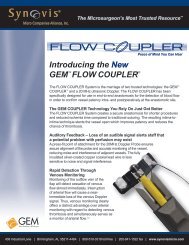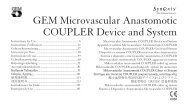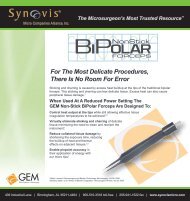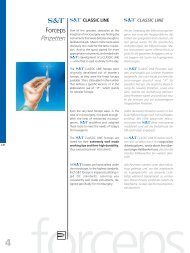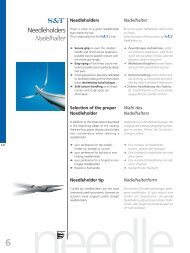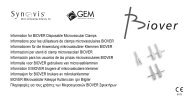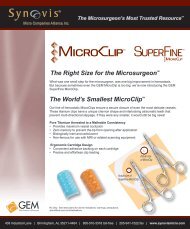IFU Neurotube Chinese.pdf - Synovis Micro Companies Alliance
IFU Neurotube Chinese.pdf - Synovis Micro Companies Alliance
IFU Neurotube Chinese.pdf - Synovis Micro Companies Alliance
You also want an ePaper? Increase the reach of your titles
YUMPU automatically turns print PDFs into web optimized ePapers that Google loves.
Absorbable Woven Polyglycolic Acid Mesh Tube<br />
(Absorbable Nerve Conduit Tube)<br />
INSTRUCTIONS FOR USE 2<br />
6<br />
1<br />
0086
SYMBOL DEFINITIONS<br />
ENGLISH<br />
Do not Reuse<br />
Consult Instructions For Use<br />
Ethylene Oxide Sterilized<br />
Do not use if the product sterilization barrier or its<br />
packaging is compromised.<br />
CAUTION: Federal (USA) law restricts this device<br />
for sale by or on the order of a physician<br />
Catalog Number<br />
Part Number<br />
<strong>Synovis</strong> Internal Code<br />
Manufacturer<br />
Authorized Representative<br />
Inner Diameter<br />
Use by<br />
Length<br />
Lot<br />
PRODUCT SIZES<br />
Catalog Number Nerve Gap Size of <strong>Neurotube</strong>*<br />
GEM0240NT _> 8mm _< 30mm 2.3 mm dia. X 40 mm length<br />
GEM0420NT _> 8mm _< 10mm 4.0 mm dia. X 20 mm length<br />
GEM0820NT _> 8mm _< 10mm 8.0 mm dia. X 20 mm length<br />
* Nominal<br />
2
INDICATIONS:<br />
The <strong>Neurotube</strong> of 2.3mm diameter is intended for use in patients with an injury to a digital nerve with 8-30mm nerve gap. The <strong>Neurotube</strong>s of 4mm and 8mm diameters are intended for use in<br />
patients with an injury to a sensory nerve with 8-10mm nerve gap.<br />
IMPORTANT NOTE: This Instructions for Use manual is designed to provide instructions for proper use of the <strong>Neurotube</strong> product. It is not intended as a reference to surgical technique.<br />
DESCRIPTION:<br />
The <strong>Neurotube</strong>® is an absorbable woven polyglycolic acid mesh tube, which is designed for primary or secondary peripheral nerve repair or reconstruction. The tube replaces the classic nerve graft<br />
technique for the repair of nerve gaps. The walls are corrugated for strength and flexibility. The corrugations prevent the tube from collapsing under normal physiological soft tissue pressures.<br />
The <strong>Neurotube</strong> is resorbed through the process of hydrolysis.<br />
ENGLISH<br />
INSTRUCTIONS FOR USE:<br />
1. Aseptically transfer the inner pouch into the sterile field.<br />
2. Visually inspect the pouch for any holes or tears; do not use if damaged.<br />
3. Open the pouch and inspect the tube; do not use if tube is kinked, brittle, or degraded.<br />
4. The nerve is surgically exposed at the appropriate incision site with the extremity under tourniquet control.<br />
5. The injured segment of the nerve must be resected distally and proximally until a nerve stump is identified with no residual intrafascicular scarring.<br />
6. Place the nerve on a wooden support (tongue depressor) and serially section with a #11 blade. <strong>Micro</strong>-scissors and larger scissors can cause the extrusion of intrafascicular components of the nerve.<br />
7. The tourniquet is released and meticulous hemostasis is obtained, so the resected end of the nerve will not fill the <strong>Neurotube</strong> with blood. The resulting blood clot would create a barrier to neural<br />
regeneration.<br />
8. Measure the nerve gap (distance between the nerve ends).<br />
9. Measure the nerve diameter and carefully select the appropriate nerve tube diameter so as not to compress the repaired nerve.<br />
10. If using the 2.3 mm diameter <strong>Neurotube</strong>, trim the <strong>Neurotube</strong> with scissors to a length 10 mm longer than the measured nerve gap, so the nerve ends may be inserted 5 mm into each end of the tube.<br />
3
ENGLISH<br />
11. A horizontal mattress stitch is used to draw the nerve end 5 mm into the <strong>Neurotube</strong>. An 8-0 suture with a 140-micron, 135° curve needle is recommended. The stitch is passed through the<br />
<strong>Neurotube</strong> from the outside to inside, transversely through the epineurium of the nerve end, and back through the tube, from the inside to the outside. Irrigation with heparinized saline<br />
facilitates drawing the nerve end 5 mm into the <strong>Neurotube</strong> and a knot is tied. It may be necessary to use a second stitch (anchor stitch) placing the suture superficially through the<br />
epineurium of the nerve and through the end of the tube.<br />
12. The corrugated external surface of the <strong>Neurotube</strong> prevents kinking as the <strong>Neurotube</strong> goes about a curve or overlies a joint surface. After one end of the nerve is secured within the<br />
<strong>Neurotube</strong>, the tube is filled with heparinized saline (10 units per cc). The second nerve end is drawn into the opposite end of the <strong>Neurotube</strong> with a horizontal mattress stitch, and if<br />
necessary, an anchor stitch may be placed.<br />
13. The tube is refilled with heparinized saline.<br />
14. An attempt should be made to position the <strong>Neurotube</strong> in a soft tissue bed, which will facilitate mobilization of subcutaneous fat between the tube and the overlying skin.<br />
15. Close the site.<br />
STORAGE:<br />
Store at room temperature, approximately 80°F (27°C) or less; avoid exposure to high humidity and prolonged extreme temperatures.<br />
WARNINGS:<br />
• Complete hemostasis should be obtained in the surgical field before the <strong>Neurotube</strong> is positioned to bridge the gap between the nerve ends.<br />
• Blood clot(s) in the lumen of the tube will impede neural regenerations.<br />
• For hand surgeries, the patient’s hand should be immobilized for three weeks following nerve reconstruction with the <strong>Neurotube</strong>. A plaster or fiberglass cast may be used for the first week and extension-<br />
block protective splint may be used for the second and third weeks. Cautiously supervised movement of the hand may be initiated before three weeks if a tendon repair is associated with the nerve<br />
reconstruction. Aggressive movement may cause the device to migrate to the surface of the skin. Should the <strong>Neurotube</strong> become exposed by movement before neural regeneration has been completed<br />
through the tube, it is suggested that the tube be removed and replaced with an autologous nerve graft.<br />
• The nerve ends should never be inserted into the <strong>Neurotube</strong> under tension.<br />
• If the nerve gap is greater than 30 mm when applying the 2.3 mm diameter <strong>Neurotube</strong>, an autologous nerve graft should be used.<br />
• If the nerve gap is greater than 10 mm when applying the 4 mm or 8 mm diameter <strong>Neurotube</strong>, an autologous nerve graft should be used.<br />
• Do not resterilize.<br />
• Discard open, unused <strong>Neurotube</strong>s.<br />
4
DISCLAIMER OF WARRANTIES:<br />
<strong>Synovis</strong> <strong>Micro</strong> <strong>Companies</strong> <strong>Alliance</strong>, Inc. (SMCA), a subsidiary of <strong>Synovis</strong> Life Technologies, Inc. warrants that reasonable care has been used in the manufacture of this device. This warranty is exclusive and<br />
in lieu of all other warranties whether expressed, implied, written or oral, including, but not limited to, any implied warranties of merchantability or fitness. Since SMCA has no control over the conditions under<br />
which the device is used, diagnosis of the patient, methods of administration, or its handling after it leaves its possession, SMCA does not warrant either a good effect or against an ill effect following its use.<br />
The manufacturer shall not be liable for any incidental or consequential loss, damage or expense arising directly or indirectly from the use of this device. SMCA will replace any device which is defective at the<br />
time of shipment. No representative of SMCA may change any of the foregoing or assume any additional liability or responsibility in connection with this device.<br />
5
<strong>Synovis</strong><br />
GEM0240NT _> 8mm _< 30mm 2.3 mm X 40 mm<br />
GEM0420NT _> 8mm _< 10mm 4.0 mm X 20 mm<br />
GEM0820NT _> 8mm _< 10mm 8.0 mm X 20 mm<br />
*<br />
*<br />
6
2.3 8-304 8 8-10 <br />
1.<br />
2.<br />
3.<br />
4.<br />
5.<br />
6. 11<br />
7.<br />
8.<br />
9.<br />
10. 2.3 mm 10 mm 5 mm<br />
7
11. 5 mm 8-0 140 135°<br />
12.<br />
13.<br />
14.<br />
15.<br />
10<br />
5 mm<br />
80°F (27°C)<br />
•<br />
•<br />
•<br />
•<br />
• 2.3 mm 30 mm<br />
• 4 mm 8 mm 10 mm<br />
•<br />
•<br />
8
<strong>Synovis</strong> Life Technologies, Inc.<br />
<strong>Synovis</strong> <strong>Micro</strong> <strong>Companies</strong> <strong>Alliance</strong>, Inc. (SMCA)<br />
SMCA<br />
SMCA<br />
SMCA<br />
SMCA<br />
9
A Subsidiary of <strong>Synovis</strong> Life Technologies, Inc.<br />
439 Industrial Lane<br />
Birmingham, AL 35211-4464 USA<br />
205.941.0111 800.510.3318 (USA)<br />
205.941.1522 (fax)<br />
synovismicro.com<br />
<strong>Neurotube</strong> is a registered trademark in the U.S.A. and Canada only<br />
U.S. Patents 4,870,966 and 5,147,399<br />
MS-13150A<br />
07/12


